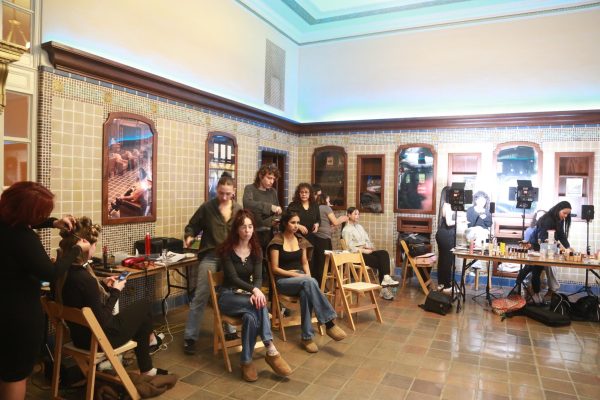In a flurry of fabric and footsteps, the Moda: In Motion spring 2025 fashion show was a celebration not just of creativity or fashion but of the people who made it possible and the community that it created.
Before the show began, enthusiasm and jitters were ubiquitous. Designers made last-minute alterations at dinner in Bartlett, models braced themselves for the night to come in Hallowed Grounds, and attendees planned their outfits more seriously than they studied for their midterms. “Are you going?” was the resounding refrain of the week.
All this nervous anticipation led up to the moment where the loudspeaker boomed at Union Station, clearing the chatter and welcoming everyone to the show. The lights turned on, the music filled the hall, and the crowd fell silent as the first model walked out in a voluminous ruffled yellow dress.
But the hush was brief. As the models strutted down the runway, the audience excitedly called out as they recognized a model or designer and murmured to each other in wonder at the caliber of the work. The models were poised, setting the pace of the show. The U-shaped runway provided a view from every angle, but the models betrayed no awareness of being watched—their walks, even at the most stylized, were perfectly assured.
Lucina Aslakson, one of the 23 student designers, found that the theme of motion was most visible in her work through the fluidity of the garments. The sleeves on her burgundy piece were oversized and made of sheer voile and gave the effect of floating as her model Nithya Arunkundrum walked. Her blue piece included a belt and arm jewelry beaded with abalone shells which shimmered as model Joslyn Jenkins moved. Jenkins moved her arms up and down as she walked, giving the impression that the shells were her wings. Her grey look was more practical. The rings sewn into the side of the pants sought to mimic cylinders in wheels, contrasting high-speed human innovations with a slow-moving animal as seen in the cow print.
The tailoring of each garment was particularly impressive, speaking to the designers’ technical mastery. Viewers murmured in appreciation at the construction of the futuristic black leather coat with strikingly oversized proportions. From a jester-inspired minidress to old-fashioned tennis costumes with accessories to match, each outfit was beautifully made and clearly conceived.
The collections were followed by whispers about how they would fit perfectly in a viewer’s wardrobe, or gasps at the architectural marvels. Each creation was a shining beacon of the designer’s individuality but incorporated with the theme of motion. The most striking takeaway wasn’t the stunning collections or avant-garde pieces but Moda’s ability to provide a creative stillness amid the bustle of everyday life.
Fittingly, the event itself was a product of explosive movement. Gabby Seiglie, another student designer, spoke of the frantic all-nighters leading up to the night and the rush of nervousness as she waited for her models to walk out. But Aslakson attested that design team leaders Mikhail Asefa and Parth Wokhlu were able to maintain a low-pressure environment, while making it evident just how high the stakes were.
We witnessed and participated in those stakes as each model walked down the catwalk. Seiglie felt incredibly nervous that something would go wrong, but as soon as her models walked out, she realized that all her hard work had been worth it. The show made the communal aspect of all her work evident. She found her community in the designer boot camp—where designers gathered every Sunday to practice their sewing skills. “I met a lot of incredible people to chat with and learn from through that experience, especially during those all-nighters that inevitably preceded the fashion show,” she said. “I am so grateful for all of the support I received from my friends both in and outside of Moda during this exciting time, and I am very excited to continue to bond with the other designers.”
Aslakson spoke of a similar sense of community, but from a different perspective, reflecting the full range of experiences the designers enjoyed. While her experience at Moda was limited to work with other designers, she felt a broader sense of community through Moda and it became most apparent for her at the show. She said, “I think the tickets selling out is really what made me realize that people in the larger community, at UChicago and beyond, were genuinely excited and interested in seeing our work.”

At the show, that sense of community was evident. The girl next to me called out, “I know her!” and I heard an excited exclamation of “That’s my friend!” as the designers took their victory laps around the runway. They were professional, but I saw the occasional smile as their friends and peers called out congratulations to them and they took in what they had accomplished. I was struck by the clothing, their skills, the venue, and the magnitude of the event, but most of all, I was struck by how close we all felt watching our classmates show us everything they’ve worked towards for the last several months. We stood and watched as Moda transformed creatives into designers, friends into an audience, and a school into a community.








